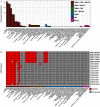A Case for Accelerating Standards to Achieve the FAIR Principles of Environmental Health Research Experimental Data
- PMID: 37352010
- PMCID: PMC10289218
- DOI: 10.1289/EHP11484
A Case for Accelerating Standards to Achieve the FAIR Principles of Environmental Health Research Experimental Data
Abstract
Background: Funding agencies, publishers, and other stakeholders are pushing environmental health science investigators to improve data sharing; to promote the findable, accessible, interoperable, and reusable (FAIR) principles; and to increase the rigor and reproducibility of the data collected. Accomplishing these goals will require significant cultural shifts surrounding data management and strategies to develop robust and reliable resources that bridge the technical challenges and gaps in expertise.
Objective: In this commentary, we examine the current state of managing data and metadata-referred to collectively as (meta)data-in the experimental environmental health sciences. We introduce new tools and resources based on in vivo experiments to serve as examples for the broader field.
Methods: We discuss previous and ongoing efforts to improve (meta)data collection and curation. These include global efforts by the Functional Genomics Data Society to develop metadata collection tools such as the Investigation, Study, Assay (ISA) framework, and the Center for Expanded Data Annotation and Retrieval. We also conduct a case study of in vivo data deposited in the Gene Expression Omnibus that demonstrates the current state of in vivo environmental health data and highlights the value of using the tools we propose to support data deposition.
Discussion: The environmental health science community has played a key role in efforts to achieve the goals of the FAIR guiding principles and is well positioned to advance them further. We present a proposed framework to further promote these objectives and minimize the obstacles between data producers and data scientists to maximize the return on research investments. https://doi.org/10.1289/EHP11484.
Figures


Similar articles
-
Daily life in the Open Biologist's second job, as a Data Curator.Wellcome Open Res. 2024 Dec 5;9:523. doi: 10.12688/wellcomeopenres.22899.2. eCollection 2024. Wellcome Open Res. 2024. PMID: 39360219 Free PMC article.
-
A Cloud-Based Platform for Harmonized COVID-19 Data: Design and Implementation of the Rapid Acceleration of Diagnostics (RADx) Data Hub.JMIR Public Health Surveill. 2025 Aug 20;11:e72677. doi: 10.2196/72677. JMIR Public Health Surveill. 2025. PMID: 40834404
-
Psychological interventions for adults who have sexually offended or are at risk of offending.Cochrane Database Syst Rev. 2012 Dec 12;12(12):CD007507. doi: 10.1002/14651858.CD007507.pub2. Cochrane Database Syst Rev. 2012. PMID: 23235646 Free PMC article.
-
Signs and symptoms to determine if a patient presenting in primary care or hospital outpatient settings has COVID-19.Cochrane Database Syst Rev. 2022 May 20;5(5):CD013665. doi: 10.1002/14651858.CD013665.pub3. Cochrane Database Syst Rev. 2022. PMID: 35593186 Free PMC article.
-
Behavioral interventions to reduce risk for sexual transmission of HIV among men who have sex with men.Cochrane Database Syst Rev. 2008 Jul 16;(3):CD001230. doi: 10.1002/14651858.CD001230.pub2. Cochrane Database Syst Rev. 2008. PMID: 18646068
Cited by
-
A minimal metadata set (MNMS) to repurpose nonclinical in vivo data for biomedical research.Lab Anim (NY). 2024 Mar;53(3):67-79. doi: 10.1038/s41684-024-01335-0. Epub 2024 Mar 4. Lab Anim (NY). 2024. PMID: 38438748 Free PMC article. Review.
-
Application of a metabolic network-based graph neural network for the identification of toxicant-induced perturbations.Toxicol Sci. 2025 Jul 1;206(1):19-29. doi: 10.1093/toxsci/kfaf065. Toxicol Sci. 2025. PMID: 40445920 Free PMC article.
References
-
- NIH (National Institutes of Health) Office of Science Policy. 2020. Final NIH Policy for Data Management and Sharing: NOT-OD-21-013. https://grants.nih.gov/grants/guide/notice-files/NOT-OD-21-013.html.
-
- European Commission, Directorate-General for Research and Innovation. 2018. Turning FAIR into Reality: Final Report and Action Plan from the European Commission Expert Group on FAIR data. https://data.europa.eu/doi/10.2777/1524 [accessed 19 June 2023]. - DOI
-
- Wellcome Trust. Open research. https://wellcome.org/what-we-do/our-work/open-research. [accessed 6 February 2023].
MeSH terms
Grants and funding
LinkOut - more resources
Full Text Sources
Medical

